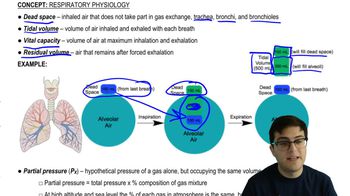Gas Exchange definitions Flashcards
Terms in this set (21)
Gas Exchange
The process by which oxygen is absorbed into the bloodstream from the lungs and carbon dioxide is expelled from the bloodstream into the lungs for exhalation.
Respiratory Physiology
Study of how organisms exchange gases (O₂ and CO₂) with their environment, involving specialized organs, ventilation mechanisms, and the role of partial pressures in gas diffusion.
Cellular Respiration
The process by which cells convert glucose and oxygen into energy (ATP), carbon dioxide, and water, primarily occurring in the mitochondria.
Volume Ratio
The ratio of an organism's surface area to its internal volume, crucial for efficient gas exchange and nutrient absorption, especially in smaller or simpler organisms.
Respiratory Organs
Specialized structures in larger animals that provide the necessary surface area for efficient gas exchange, facilitating the intake of oxygen and expulsion of carbon dioxide.
Lungs
Organs that facilitate gas exchange by providing a large surface area for oxygen to enter the bloodstream and carbon dioxide to be expelled from the body.
Trachea
A tube in the respiratory system that conducts air from the larynx to the bronchi, providing a clear airway for breathing and protecting the respiratory tract from foreign particles.
Bronchioles
Small airways in the lungs that branch off from the bronchi, leading to the alveoli where gas exchange occurs. They lack cartilage and are involved in controlling airflow resistance and distribution.
Alveoli
Tiny air sacs in the lungs where oxygen and carbon dioxide are exchanged between the air and the bloodstream.
Capillaries
Tiny blood vessels where oxygen and carbon dioxide exchange occurs between blood and tissues, facilitated by their thin walls and extensive network surrounding alveoli.
Diaphragm
A dome-shaped muscle that contracts to create negative pressure, expanding the thoracic cavity and drawing air into the lungs, essential for mammalian respiration.
Thoracic Cavity
The body cavity located between the neck and diaphragm, housing the heart, lungs, esophagus, and major blood vessels, and playing a crucial role in respiration and circulation.
Dead Space
Volume of air in the respiratory system that does not participate in gas exchange, remaining in the trachea, bronchi, and bronchioles.
Vital Capacity
The maximum volume of air that can be exhaled after a maximum inhalation, including tidal volume, inspiratory reserve volume, and expiratory reserve volume.
Residual Volume
The volume of air remaining in the lungs after a maximal exhalation, ensuring that the lungs do not collapse and continue to facilitate gas exchange.
Partial Pressure
The hypothetical pressure exerted by a single gas in a mixture if it alone occupied the entire volume, influencing gas diffusion based on its concentration gradient.
Fick'S Law
The rate of gas diffusion is influenced by surface area, diffusion distance, and partial pressure differences, with higher surface area and partial pressure differences, and shorter distances increasing diffusion rates.
Cooperative Binding
A property where the binding of one molecule to a protein enhances the binding affinity of additional molecules, often through a conformational change in the protein's structure.
Bohr Shift
A physiological phenomenon where hemoglobin's oxygen-binding affinity decreases due to lower pH or higher CO2 levels, enhancing oxygen release in metabolically active tissues.
Carbonic Acid
A weak acid formed when CO2 dissolves in water, playing a crucial role in maintaining blood pH and facilitating CO2 transport in the body.
Medulla Oblongata
A brainstem region that regulates vital functions like breathing, heart rate, and blood pressure by processing signals from the body and sending appropriate responses to maintain homeostasis.



